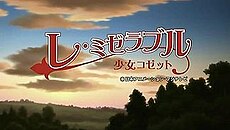This article needs additional citations for verification. (November 2021) |
Les Misérables: Shōjo Cosette (レ・ミゼラブル 少女コゼット, Re Mizeraburu Shōjo Kozetto, lit. "Les Misérables: Little Girl Cosette") is a Japanese anime series produced by Nippon Animation, and the first installment in the World Masterpiece Theater series in ten years after Remi, Nobody's Girl.[1] It is an adaptation of Victor Hugo's classic 1862 novel Les Misérables, and the fourth anime adaptation of said novel (following two adaptations from the Japanese television program Manga Sekai Mukashi Banashi, and a 1979 TV film special produced by Toei Animation).
| Les Misérables: Shōjo Cosette | |
 Title card | |
| レ・ミゼラブル 少女コゼット (Re Mizeraburu Shōjo Kozetto) | |
|---|---|
| Genre | Drama, historical fiction |
| Anime television series | |
| Directed by | Hiroaki Sakurai |
| Produced by | Kōichi Motohashi |
| Written by | Tomoko Konparu |
| Music by | Hayato Matsuo |
| Studio | Nippon Animation |
| Original network | BS Fuji, Animax, Spacetoon |
| Original run | January 7, 2007 – December 30, 2007 |
| Episodes | 52 |
It premiered across Japan on January 7, 2007, on Fuji TV's BS Fuji broadcast satellite network, and contains twenty-six episodes each season, for a total of fifty-two episodes. It also aired in Japan on Animax beginning in April 2007.
Plot
editSet in nineteenth century-era France, the series begins with Cosette, a three-year-old girl, traveling with her mother Fantine, who is trying to find a job and a place to live, but have always been shunned away due to few employers hiring single mothers. When her mother is promised with the prosperity of working in the big city, Cosette is separated from her in the hopes a caretaker named Thénardier will watch over her while her mother earns some money, but this was a trick and the caretaker is a corrupt man who makes Cosette his indentured servant, or more precisely his slave. Then, the kind mayor—formerly a convict named Jean Valjean—of the town that Cosette makes her new home in, sees how winds of change are so detrimental for children and families, and decides to do something about it, but forces Cosette to go on the run to escape his returning, difficult past.
Characters and cast
editEpisodes
edit- Fantine and Cosette
- Jean Valjean's Secret
- A New Friend, Chou Chou
- Mother's Letter
- Javert's Suspicions
- Cosette's Birthday
- Lost Eponine
- Mother's Skirt
- Thenardier's Malice
- Madeleine is Perplexed
- Sister Simplice's Lie
- Lonely Cosette
- Jean Valjean and Cosette
- Their Journey
- Their Bond
- The Gorbeau House in Paris
- Javert Closes In
- A Forgotten Reunion
- Cosette is Taken
- Monastic Life
- Marius Pontmercy
- Their Respective Journeys
- Under The Parisian Sky
- An Encounter in the Luxembourg Garden
- Unreachable Feelings
- Chance Encounters in Paris
- The Girl Who Ran Away
- The Found Letter
- Thenardier's Trap
- The Coin That Was Left Behind
- The Quiet Rue Plumet
- Traces of That Day
- Giving Up On Reunion
- Children In The Elephant
- Patron Minette's Breakout
- The Ailing of Paris
- Marius's Miscalculation
- Cosette and Eponine
- June 5, 1832
- The Night of the Revolution
- Eponine's Love
- A Letter from Marius
- Gavroche's Wish
- To the Light of the Future
- The Sewers of Paris
- Javert's Justice
- The Bonds of the Hearts
- Cosette and Marius
- My Mother
- The Eternal Ring
- The Revealed Truth
- Silver Silver Candlesticks
Staff
edit- Original story: Les Misérables by Victor Hugo
- Producer: Kōichi Motohashi
- Planning: Kazuya Maeda (Fuji TV), Kōhei Sano, Kazuka Ishikawa
- Production manager: Ken'ichirō Hayafune
- Series composition: Tomoko Kanparu
- Character designs: Hajime Watanabe, Takahiro Yoshimatsu
- Chief animation director: Tadashi Shida
- Background artist: Kazue Itō
- Art director: Mitsuki Nakamura
- Color design: Tomoko Komatsubara
- Photography director: Seichi Morishita
- Sound director: Hiroyuki Hayase
- Music: Hayato Matsuo
- Music producers: Hitoshi Yoshimura (Index Music), Daisuke Honji (Index Music)
- Producers: Yukihiro Itō (Fuji TV), Kōji Yamamoto (Fuji TV), Michio Katō, Ken'ichi Satō
- Director: Hiroaki Sakurai
- Production: Fuji TV, Nippon Animation
Theme songs
edit- Opening theme: Kaze no Mukō (風の向こう)
- Performance: Yuki Saitō (Index Music)
- Ending theme: Ma Maman (Watashi no Okā-san) (ma maman (私のお母さん))
- Performance: Yuki Saitō (Index Music)
Reception
editThe anime was dubbed and broadcast in:
- Arab World by Venus Centre
- Italy under the title The Heart of Cosette
- Hong Kong
- Iran under the title Poor: A girl named Cosette
- South Korea
- Philippines under the title Ang Pangarap ni Cosette ("The Dreams of Cosette"); discontinued due to Typhoon Ondoy
See also
editReferences
edit- ^ レ・ミゼラブル 少女コゼット. Digital Daijisen Plus (in Japanese). Shogakukan. Retrieved November 2, 2021 – via Kotobank.
External links
edit- Nippon Animation's official Shōjo Cosette website (in Japanese)
- BS Fuji's official Shōjo Cosette page (in Japanese)
- Animax's official Shōjo Cosette page (in Japanese)
- Les Misérables: Shōjo Cosette (anime) at Anime News Network's encyclopedia
- Les Misérables: Shōjo Cosette at IMDb